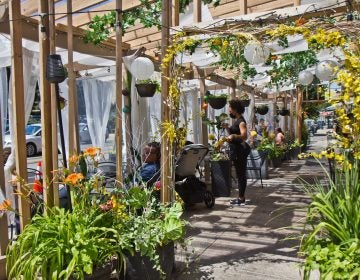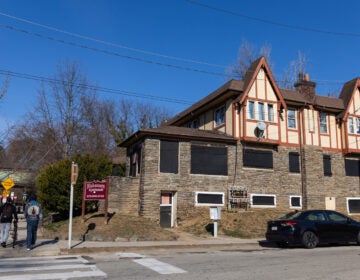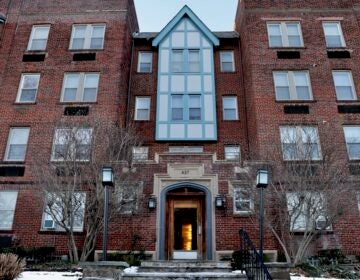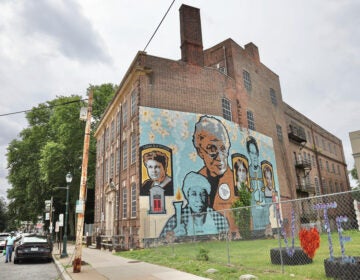What Germantown can learn from Lauryn Hill
David Rose moved to Germantown in 2016 to take care of the Black Writers Museum. As he prepares to leave Philly, he reflects on the lessons he learned.

David Rose on the steps of the Black Writer’s Museum in Philadelphia’s Germantown Neighborhood. (Kimberly Paynter/WHYY)
On November 1, 2016, I moved into the historic Germantown section of the city with a set of well-defined goals. I was going to use my role as the new resident caretaker for the nation’s only Black Writers Museum to unify the 338-year-old Germantown community around historic preservation. The mission was not quite hood tours and Bellini brunch on Sundays at the Germantown White House. Instead, I saw an opportunity to use the community’s history as a tool to bring groups together in the name of economic development without displacement. However, the litter in Germantown could not be ignored and struck me as a contemporary challenge that both detracted from the beauty of the environment and diminished the esteem of its residents. I turned my attention toward cleaning the streets and my plans seemed to go up in smoke. The question of why that happened can’t be answered without first understanding how we got to this point in time when Germantown and other Philadelphia neighborhoods haven’t gotten the investment they need to begin with.
How historic neighborhoods become sites of speculation
The answer is rather long and complex but it has roots in contemporary misinformation and fear.
Professor Henry Louis Taylor, at SUNY Buffalo’s School of Architecture and Planning, teaches us about what he calls “the racialization of space and the spatialization of race.” I have always seen this notion as an urbanist framework that speaks to the innocence of natural environments before they are given a socioeconomic or cultural identity. Old industrial sections of the city lack adequate investment because the housing stock was built and maintained by the presence of industry in those places. When the economic driver in those areas left, working families either relocated or maintained their homes in communities without industry and, subsequently, without the necessary investment.
American cities developed as a result of diverse groups gathering for cultural exchange. What began as varied Indigenous nations meeting to share wisdom, rations, and ritual, through time and influence, developed into the exchange of goods, services, and energy within the cultural context of factories during the industrial age. Families in contemporary urban enclaves became disconnected from their sacred artistic and agrarian pasts, regardless of their cultural backgrounds or economic realities.
This is why the division of people by socioeconomic and cultural identifiers is so unsustainable: Reducing the complexities of post-industrial urban decline to matters of race truncates the historic relationships we have had with one another within the natural urban environment that predates the Industrial Revolution. When those relationships are forgotten or ignored, misinformation and fear begin to guide perceived value. When we cannot experience safety in our city, it is because there is no incentive for, or investment in, the creation of Native and African American safety in the urban context.
In historic Germantown, knowing the facts of contemporary urbanism was not enough. Since long before the American Revolution, politicians and speculative real estate developers have realized that they could make a living from the warehousing of people inside of settler colonial municipalities and subdivisions at the expense of farmers, artists, and artisans. They utilize their investment of money to pay for the silence of institutions from universities and community development corporations to city agencies and legacy institutions like local historical societies.
Strengthening the collective ‘we’ through elevating community voices.
On March 9, 2017, the 20th anniversary of the assassination of Brooklyn born rapper Christopher Wallace (b.k.a. The Notorious B.I.G.), I registered Sally Blagg in Pennsylvania as an environmental design consulting firm. The incorporation date was inspired by the musicians, authors, visual and performing artists who continue to play an undervalued yet critical role in the documentation of contemporary urbanism.
I created Sally Blagg with the belief that sustainable city planning and urban design should shine a light on the intrinsic value inherent in the living culture of a place through a trauma-informed process that builds capacity. Dean Robert Shibley, of the Buffalo School of Architecture & Planning, makes clear in his teachings that “community and economic development is a conversation that we are always either joining or leaving, we do not own the planning or design process. The community was planning before we arrived.”
So, from its inception, Sally Blagg was, and still is, in alignment with this value of community-centered planning. This means that our firm is “committed to architecture and planning as interdisciplinary problem-solving enterprises, rooted in social engagement, nourished by research-in-practice, animated by making and doing, and committed to meeting the needs of clients, communities, and society in an increasingly complex urban world.” Our work in historic Germantown was an attempt at activating these values.
What I, as principal curator, was not prepared for was the cultural narcissism of well-heeled developers unwilling to engage in a process of mutually beneficial accountability partnership.
When you have your hand in the lion’s mouth, sometimes you have to eeeeeeease it out!
In the song “Oh Jerusalem,” the musician Lauryn Hill says, “we grin and shake hands, then lay ambush for the man, who has a different point of view than us.” She goes on to frame the root of this behavior: We are “infuriated, ‘cause he doesn’t understand, bringing up those things we don’t want to discuss.”
This artistic framing of narcissistic rage, unable to face itself in the light of historical truths, makes solutions-oriented action almost impossible. How do we restore the environments that developers have already decided to destroy? How do we preserve cultural landscapes for the people living their contemporary lives in these sacred spaces? Who is keeping their stories?
“When you are ready, the teacher will appear!”
Over the past 15 years I have learned that cities themselves, from Buffalo to Philadelphia, have the potential to create the perfect backdrops for independent study and subsequent self-discovery. I am reminded of North Carolina based artist Joshua Gunn, who gave a speech while I was studying at North Carolina A&T, saying “you need to leave places in a better condition than when you arrived.” The time I spent inside of the industrial education system could not show me how to work through the insecurities, implicit biases, and fear that I did not understand fully until sitting in the soil with them in historic Germantown. The greatest lesson learned from my experience in Philadelphia was to keep on following the music: The music is the language of a thriving culture inside of a genocidal environment.
This autumn I will be transitioning out of the Philadelphia region so that we can continue deep and sustained impact work in the Appalachian region that our company’s namesake called home. We will continue to entertain contracts for curriculum development, institutional capacity-building, and biophilic design in the city and region after our relocation as it is our intent to see under-resourced communities benefit equitably from development between now and the United States Semiquincentennial in 2026.
When we moved to Philadelphia, we came with the inspiration of my mother in mind with a goal to help foster safe spaces for cultural exchange where women and girls could feel secure enough to create fearlessly. This was the work of my mother and, according to her, “a long line of stroooong Black women” that she defined as our maternal line. So, as we leave Philadelphia we think about all the strong women coming up in Germantown. Our success will be defined by the next generation of young girls coming out of 19144 and Sally Blagg will be ready to offer those young women an opportunity to design safe spaces in the world with us.
David Rose is Principal Curator at Sally Blagg, an American design consulting firm utilizing critical ethnography and ethnomusicology to develop solution-oriented strategies to inform systems changes.

Subscribe to PlanPhilly
WHYY is your source for fact-based, in-depth journalism and information. As a nonprofit organization, we rely on financial support from readers like you. Please give today.









